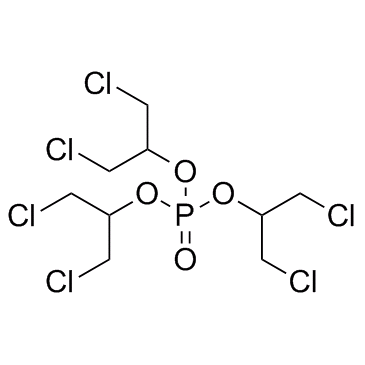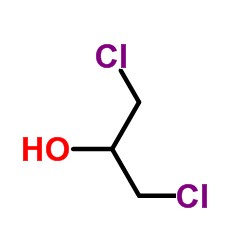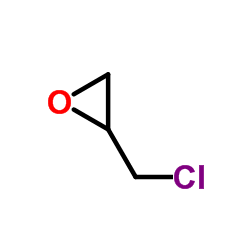13674-87-8
| Name | Phosphoric Acid Tris(1,3-Dichloro-2-Propyl) Ester |
|---|---|
| Synonyms |
Phosphoric Acid Tris(1,3-dichloro-2-propyl) Ester
Tris(1,3-dichloro-2-propanyl) phosphate Tri(β,β'-dichloroisopropyl) phosphate MFCD00083121 Tris(1,3-dichloropropan-2-yl) phosphate TDCPP Tris(1,3-dichloroisopropyl) phosphate EINECS 237-159-2 Tris(1,3-dichloro-2-propyl) phosphate 1,3-Dichloro-2-propanol phosphate (3:1) Phosphoric acid, tris(1,3-dichloro-2-propyl) ester G1Y1GOPO&OY1G1G&OY1G1G 1,3-Dichloro-2-propanol phosphate (Phosphoric acid tris(1,3-dichloro-2-propyl ester) Tris(2,2′-dichloroisopropyl) phosphate |
| Description | TDCPP is a chlorinated analog of tris(2,3-dibromopropyl)phosphate (Tris) which is one of the most detected organophosphorus flame retardants (OPFRs) in the environment. |
|---|---|
| Related Catalog | |
| In Vitro | Exposure to TDCPP does not significantly affect cell viability until at concentration >68 μg/mL. HCECs show a 16% cell viability loss after exposing to 136 μg/mL TDCPP. Moreover, TDCPP induces a sharp decrease in viable cells (87%) after exposing to ≥272 μg/mL TDCPP. Based on cell viability, the LC50 value for TDCPP is 202 μg/mL using a nonlinear regression. Compare to controls, TDCPP-exposed cells exhibit a concentration-dependent increase in apoptosis. Anti-apoptotic Bcl-2 protein expression is increased to 1.4 fold after exposing to 2 μg/mL TDCPP, 1.2-folds at 20 μg/mL but dynamically decreased to 0.4 fold at 200 μg/mL compare to control. The caspase-3 activity is increased to 2.1 folds of the control at 200 μg/mL TDCPP[1]. TDCPP inhibits cell growth at lower concentrations (IC50 of 27 μM), while cell viability and toxicity are affected at higher concentrations (IC50 of 171 μM and 168 μM, respectively)[2]. |
| Kinase Assay | The cellular ATP contents are determined in HCECs grown in DMEM containing 0, 2, 20, or 200 μg/mL TDCPP using a luciferase-based ATP assay kit according to the manufacturer's guideline. Briefly, after 24 h exposure, HCECs are lysed with lysis buffer. Lysates are then centrifuged at 12,000 g at 4°C for 5 min. Then, 100 μL of supernatant is mixed with 100 μL ATP detection working dilution. Luminance is examined by an fluorescence microplate reader[1]. |
| Cell Assay | To examine the effects of TDCPP on cell viability, HCECs are planted into 96-well plate (100 μL/well) at density of 1×105 cells/mL overnight. Then, the medium is changed into fresh medium containing 0.034, 0.34, 3.4, 34, 68, 136, 272, or 340 μg/mL of TDCPP and solvent vehicle (0.1%, v/v) and incubated for 24 h. Cell viability is detected using CCK-8 cell viability assay kit according to the manufacturer's instructions. After exposure, cellular morphology is observed and recorded by an inverted microscopy[1]. |
| References |
| Density | 1.5±0.1 g/cm3 |
|---|---|
| Boiling Point | 457.4±40.0 °C at 760 mmHg |
| Melting Point | -64°C |
| Molecular Formula | C9H15Cl6O4P |
| Molecular Weight | 430.905 |
| Flash Point | 377.7±35.0 °C |
| Exact Mass | 427.883911 |
| PSA | 54.57000 |
| LogP | 1.79 |
| Vapour Pressure | 0.0±1.1 mmHg at 25°C |
| Index of Refraction | 1.497 |
| Water Solubility | <0.1 g/100 mL at 24 ºC |
CHEMICAL IDENTIFICATION
HEALTH HAZARD DATAACUTE TOXICITY DATA
MUTATION DATA
|
| Symbol |


GHS08, GHS09 |
|---|---|
| Signal Word | Warning |
| Hazard Statements | H351-H411 |
| Precautionary Statements | P273-P281 |
| Personal Protective Equipment | Eyeshields;Faceshields;full-face respirator (US);Gloves;multi-purpose combination respirator cartridge (US);type ABEK (EN14387) respirator filter |
| Hazard Codes | Xn: Harmful;N: Dangerous for the environment; |
| Risk Phrases | R20/21/22 |
| Safety Phrases | S26-S36/37/39-S61 |
| RIDADR | UN 3082 9/PG 3 |
| RTECS | UB1473000 |
| HS Code | 2919900090 |
|
~% 
13674-87-8 |
| Literature: Journal of the Chemical Society, , p. 826 |
|
~% 
13674-87-8 |
| Literature: J. Gen. Chem. USSR (Engl. Transl.), , vol. 36, # 8 p. 1454 - 1459,1461 - 1464 |
| HS Code | 2919900090 |
|---|---|
| Summary | 2919900090 other phosphoric esters and their salts, including lactophosphates; their halogenated, sulphonated, nitrated or nitrosated derivatives。supervision conditions:AB(certificate of inspection for goods inward,certificate of inspection for goods outward)。VAT:17.0%。tax rebate rate:9.0%。MFN tariff:6.5%。general tariff:30.0% |



